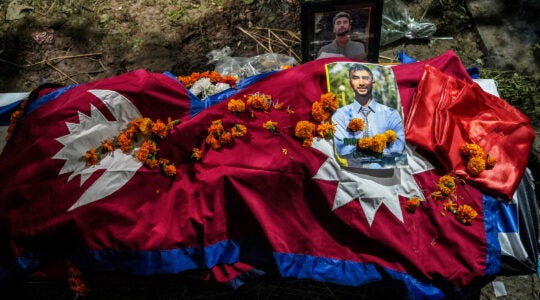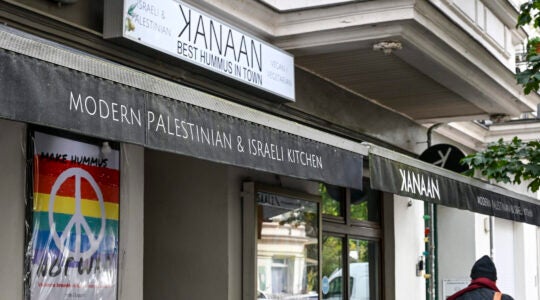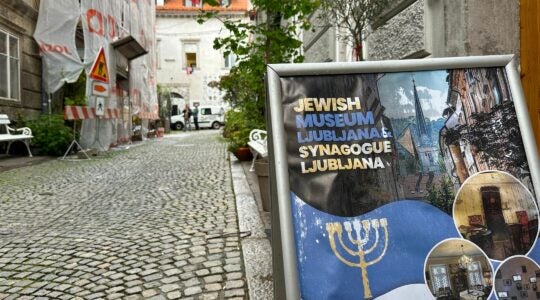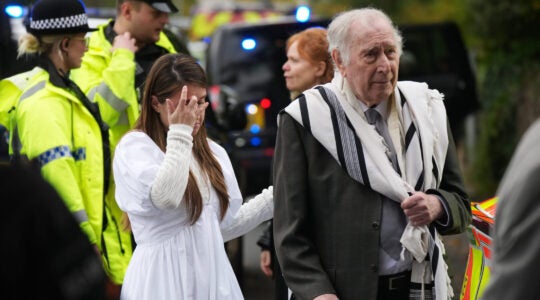
Vilen Molotov-Luchanskiy, standing in front of the lone memorial in Karaganda to gulag victims, says his grandmother’s faith in the Soviet system never wavered despite eight years in the gulag. (Michael J. Jordan)

The Dolinka cemetery was designated for children who died while living with their mothers in the village’s prison-labor camps. (Michael J. Jordan)

A cross marks the grave of a child who died while living with its mother in a Dolinka prison-labor camp. (Michael J. Jordan)

One statue of Soviet leader Vladimir Lenin has been preserved in the Kazakh village of Dolinka. (Michael J. Jordan)

The path of a Dolinka villager hints at a life on the Kazakh steppes, or prairie, that can be simple but hard. (Michael J. Jordan)

Karaganda Jewish activist Bela Kamenetskaya, with fellow activist Alexander Abramovich, explains what it’s like to hail from the notorious city. (Michael J. Jordan)

Many of the former women’s barracks in the Dolinka prison-labor camps are now abandoned and decaying. (Michael J. Jordan)

Many of the former women’s barracks in the Dolinka prison-labor camps are now abandoned and decaying. (Michael J. Jordan)

The villa of the former commander of the Dolinka prison-labor camp is occupied today. (Michael J. Jordan)

Young girl living today in Dolinka, once the administrative center of the Karaganda network of prison-labor camps known as the gulag. (Michael J. Jordan)
KARAGANDA, Kazakhstan (JTA) — Liza Luchanskiy was born to a poor, Yiddish-speaking family in Berdichev, the historic, heavily Jewish city deep in the Pale of Settlement. Lured by Soviet promises of equality, she became a communist true believer, working her way up to serve on a committee in Siberia that targeted so-called enemies of the revolution.
But her zeal wasn’t enough to save her or her similarly devoted husband, Josef.
They were swept up during the frenzy of Stalin’s Great Terror, from 1937 to 1939. Josef was shot by a firing squad in 1938, and Liza was exiled by cattle car to Karaganda.
Luchanskiy was sentenced to eight years in the vast network of forced-labor camps here, on the southern edge of Stalin’s fearsome gulag. Enduring extreme cold, hunger and exhaustion, which afflicted her health ever after, Luchanskiy never let go of her faith in communism, her grandson says.
“She never blamed the system, only Stalin,” says Vilen Molotov-Luchanskiy, an internist who today heads the Jewish Cultural Center in Karaganda.
As many as 1.2 million Soviet citizens — spanning practically all the myriad ethnic groups nationwide — were worked to death or near death in the 75 camps that comprised Karaganda. Among them were many Jews, including many rabbis.
“There is no separate story of Jews here in Stalin’s gulag,” offers Mikhail Kreichman, who teaches Jewish history and tradition in Astana. “Many, many other nations suffered in there.”
The heart of the Karaganda slave labor machine was the railroad hub of Karaganda city, in central Kazakhstan. Once the camps were closed and emptied, it became a virtual “city of ex-convicts.”
Visiting the city today, remnants of that era can be felt still in the collective psyche and in the identity of the Jews that remain, making the Karagandan community among the more unique in the Diaspora. It may be the least assimilated Jewish community in Kazakhstan, which has some 15,000 to 20,000 Jews, because so many of the Jews here are children or grandchildren of rabbis and other traditional Jews sent to the Karaganda labor camps.
The purges of the late 1930s injected large numbers of Jews to Kazakhstan. Before that, the few Jews here either were descendants of Russian Jewish soldiers who settled in the area in the 19th century or fragments of Silk Road Bukharan Jews.
Jewish life pulsates today in Karaganda, which has 1,500 registered Jews. Chabad-Lubavitch opened its second day school in Kazakhstan here. There is a rabbi in town. The community hosts an annual festival for Jewish youth that draws some 200 participants from around the region. Last Purim, some Jews from Karaganda took a four-hour bus ride to the Kazakh capital Astana to celebrate the holiday at a synagogue there.
But the Jews here are best known for the painful history of Karaganda. When local Jews travel to other ex-Soviet republics, the mere mention of their hometown — now Kazakhstan’s third-largest city — typically elicits the same reaction.
“ ‘Your family was in this camp?’ That’s what they know about Karaganda,” says Bela Kamenetskaya, the head of the local Hesed welfare office. “If they come here, they expect it to look like Auschwitz. They’re surprised to see we have streets, city squares and an airport.”
Jews here say they share a special bond with their Karaganda neighbors because they all suffered together.
“The pain that every family suffered unites us even today,” says David Bitsadze, a taxi driver.
Karaganda has a lone monument to its victims nestled within a modest park. Among the trees is a striking wooden memorial, part of it carved with a cross, an Islamic crescent and a Star of David. Another part reveals tormented faces covered in barbed wire. A marble slab reads, “This soil is soaked with blood, covered by bones of the dead.”
The gulag kicked into high gear after World War II, as Moscow exploited its bottomless slave labor to rebuild a ravaged country. The region was home to four special camps renowned for brutality, as highlighted in Alexander Solzhenitsyn’s landmark expose “The Gulag Archipelago.”
Stalin’s prisoners, convicted as “enemies of the people,” were shipped to the hinterlands, typically for eight to 10 years, to toil in mines, factories or farming. In Karaganda, they extracted coal and copper, with some agriculture. Most died of starvation, disease or the cold.
One camp here was designated for the Wives of Traitors of the Motherland, housing women and their children after the husbands were shot. Still others were deported here as “internal exiles,” restricted to living in certain villages.
In a rare sign of resistance, rebellions erupted in late 1952, and again shortly after Stalin’s death in 1953. The next year the camps were shuttered.
Free to go, those who had family waiting for them back home left. Those who didn’t stayed. In some cases their laid-off jailers lived nearby.
Meanwhile, with the camps abolished, Karaganda turned boomtown. The 1960s saw a new wave of Jews: young professionals or recent graduates either ordered to the Soviet empire’s outer reaches to fill a need, or seeking work opportunities in the “virgin soil” of Kazakhstan.
Jewish professors were instrumental in creating Karaganda’s medical school, which became one of the Soviet Union’s finest, says local Jewish activist Alexander Abramovich.
“They knew they wouldn’t be deported from here,” Abramovich says with a smile.
Today, little commemorates Karaganda’s notorious past beyond the sleepy village of Dolinka, the administrative center of the camp network, 30 miles southwest of the city.
On one side of the road to Dolinka is a former labor camp, recognizable by its watchtower — conveniently it’s been converted into a prison for garden-variety criminals. On the other side is a village of yellow sandstone homes built exclusively for officers who ruled the gulag.
In Dolinka itself, abandoned barracks that once housed women are crumbling from age and neglect. The commander’s villa is inhabited, though, with two satellite dishes planted in the front yard. A memorial museum sees a trickle of somber visitors, many of whom have come to learn about the fate of loved ones.
Moscow continues to withhold many files, says museum director Marina Klyshnikova, perhaps because of sensitivity over the perpetrators.
“Some of them are still alive,” she says.
Molotov-Luchanskiy says his grandmother spoke daily about her earlier life until she died in 1980 at age 81. Speaking Yiddish, she would tell him tales of the camp and of his grandfather.
“She wanted me to know that life wasn’t so simple, or so easy,” Molotov-Luchanskiy says.
“Hers was actually a story of a happy woman,” he adds. “In life she had a great purpose, a great love and great suffering. She thought it was everything an ordinary Jewish girl could want.”
JTA has documented Jewish history in real-time for over a century. Keep our journalism strong by joining us in supporting independent, award-winning reporting.





